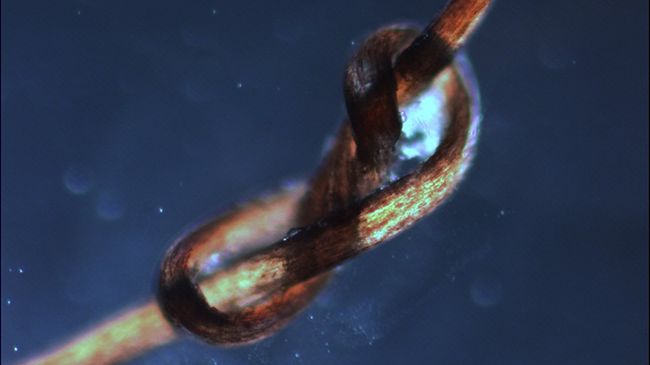
Writer Dr. Kari Williams has been styling celebrities at her salon Mahogany Hair Revolution, in Beverly Hills, for 18 years. She even has her PhD in Trichology (the science of hair loss + disorders of the scalp”>.
Do you have single strand knots? They may feel like little beads along the hair shaft. They are annoying, and to remove them many women comb as much hair as they can towards the front of their head, grab a pair of scissors and begin clipping away any knots in view. First, let me state that I do not advocate trimming your own hair, especially with any pair of scissors. Dull scissors can fray the ends of the hair shaft, leaving them in the same condition they were in before the makeshift trim, if not worse.
First, let me state that I do not advocate trimming your own hair, especially with any pair of scissors.
Most importantly, there are some irregularities of the hair shaft that cause consistent knotting. This is most commonly seen in curlier hair types. Unfortunately, some women will experience knots along their hair shaft on a regular basis. These knots are not always at the end of the hair shaft; instead, single or multiple knots can be seen and felt along the length of the hair shaft. This phenomenon has been nicknamed single strand knots or “fairy knots,” but the technical term is trichonodosis.
Why does curly hair knot more easily?
Curly, coiled strands are produced by a flat, curved hair follicle. The curly hair strand that grows out of this follicle tends to weave and loop around other hair strands causing the strands of hair to easily become knotted together. Now this is common in curly hair types. The ultimate concern is when this becomes a chronic problem and a single, or sometimes double knot occurs in the hair shaft. Short, curly hair and tightly coiled hair types are particularly susceptible to this type of knotting.
What causes knots?
A considerable number of slack knots are often produced by friction from pillows or various hair manipulations, especially when shampooing. Combing the hair with combs that have fine teeth may tighten the knots and even pull out hairs from the scalp prematurely. As a result, wide tooth combs are always the best option when combing through the hair.
How to prevent fairy knots
Extreme care must be taken to reduce the amount of excessive knotting of the hair shaft. Here are 7 ways to prevent and/or decrease the occurrence of single strand knots (trichonodosis”>:
1. Always detangle your hair before shampooing
When hair is not detangled, the water will cause your curls to tighten around any existing knots or build up in the hair. This makes combing the hair after the shampoo more difficult and frustrating.
2. While shampooing, do not pile the hair on top of the head
Instead, massage the shampoo directly in to the scalp with the pads of your fingertips and gently finger comb the shampoo through the length of your hair in a downward motion to keep the hair free of tangles.
3. Blot your hair dry
When drying the hair it is always best to blot the hair dry and squeeze excess water from the hair. Do not use harsh movements with the towel.
4. Decrease friction at night
When preparing for bed, braid or twist the hair in sections to decrease the friction and matting that can be caused while the hair is loose.
5. Strengthen your strands
Incorporate reconstructing deep conditioners or protein treatments into your conditioning routine on a regular basis to keep the hair shaft strong.
6. Lubricate your strands
Keep your hair well lubricated with the use of natural and essential oils. The oils coat the hair strand, which helps to reduce friction, tangling and knotting.
7. Schedule regular trims
Have a professional trim your ends on a regular basis. On average for women who wear their hair natural, that’s once every 3-4 months, but it may be more frequently for those who have tighter coils and experience knots on a regular basis. So, monitor your hair growth cycle and how your hair feels a month or two after a trim. If you start to notice that your hair tangles more during and after a shampoo and/or you feel knots in your hair that is a sign you need a trim.
What if you can’t get rid of a knot?
If you have knots in your hair shaft that you cannot undo, the only and best way to get rid of them is to cut them with proper shears. Do not comb, yank, pull, tear or use your kitchen scissors to remove the knots. You are only further damaging your hair. Lastly, do not get frantic if you are experiencing this problem. It is a common occurrence for some curly girls and comes with the territory of having curly hair. As long as you have the proper tools and information to manage the problem and prevent it from getting worse, you and your hair will be happy.
Do you experience single strand knots? How do you combat them?
This article has been updated.
